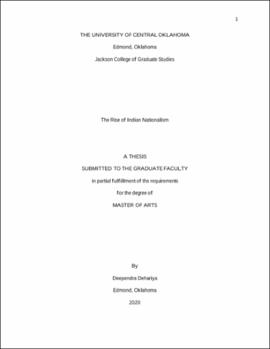| dc.description.abstract | This thesis will focus on the Amritsar Massacre 1919, that happened in Amritsar, Punjab,India (part of which lies in present-day Pakistan after the 1947 Separation) and its importance in India's rise of nationalism. This topic, even though explored extensively, left most historians with two conclusions: one from India, stating they wanted an apology from the British Empire because it happened under their reign and their General was responsible for the massacre; The other conclusion is a British perspective that makes General Dyer the scapegoat . It was because of him losing control and taking the actions into his own hands before reporting to his superiors in the Empire. I want to find out what happened and what points have been overlooked or excluded from people. Also, I am going to focus on the Commissioners Report appointed by the Punjab Sub-committee of the Indian National Congress and the eyewitness accounts that they recorded. This will showcase the feelings that the people had before and after the Massacre and what was their opinion regarding British rule in India. Punjab was an important region of British India, partly because of its religious diversity, which incorporated substantial numbers of Muslims, Hindus, and Sikhs. It was also a strategic strong point as the province bordered Afghanistan. The Jallianwala Bagh Massacre was and remained a very emotional topic for India's people, especially in Punjab. The true account of the incident can only be understood by looking at several different arguments made by people across the world. Since this event attracted historians and authors from other parts of the world, it gives us a perspective that cannot be extremely biased towards one nationality. The documents and evidence used in this research are found in The National Archives in London and had not been accessed since 1972. It is clearly time for a new evaluation of this event. This research and these documents play a key role in substantiating the theory that this was not a reactionary event Deependra Dehariya Nationalism in India, 1919-47 or was it an event of one man’s mental instability. It was a planned event by the British to circumvent their fear that India will revolt against them. Methods: I have analyzed all the published books about the event. Then, after understanding an overview of the event, I examined the Primary sources and Cabinet records of Britain and the reports gathered by Gandhi (Ji) and his colleague. I also inspected the maps that were available in the reports and cabinet records both by Indians and British, which showed the disturbances in Punjab and in India. The maps also showed disturbances all over India and how the British had “prevented it.” This can be concluded only through an analysis of the chain of events that happened leading to the massacre at Amritsar that it was a planned event. If there is future research on this topic, it should be focused on what it meant for India and Punjab. Did they echo the same feelings of Nationalism that was seen in Gandhi (Ji)’s Satyagraha, or was it something different? Focusing on the eye-witness accounts and examining them thoroughly is a better and new direction in this research. This will also provide a social history’s account, and it will be bottom-up research. | en_US |
